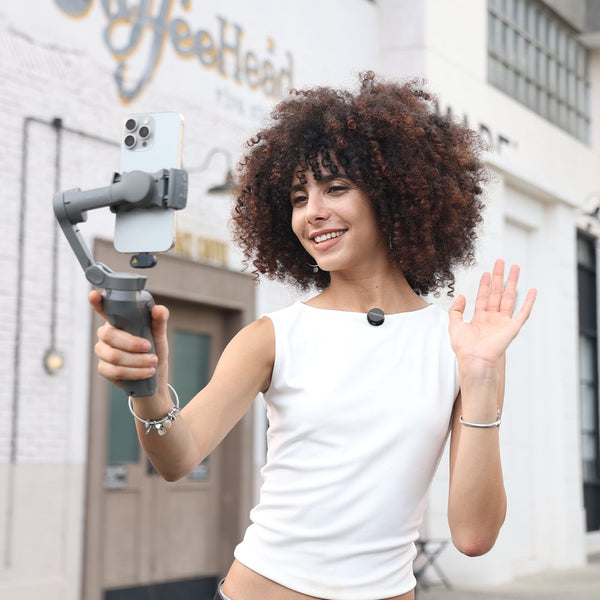Your logo is the face of your brand—it says everything about your business, and creating one for your small business can be a challenge, especially if you don’t know where to start or don’t have the right tools. In this article, we’ll explore the essentials of a brand logo and how a wireless microphone can help you vlog about using a reliable design template platform.
Introduction: Why a Professional Logo Matters for Your Brand Identity
A logo is more than just a graphic—it’s the visual heart of your brand. In 2025, with competition fiercer than ever, your logo serves as the first impression for potential customers. A well-crafted logo communicates professionalism, trustworthiness, and the essence of your brand identity. Whether you’re building a startup, running a personal brand, or refreshing your business look, investing time into designing the right logo can make the difference between blending in and standing out.
When you’re promoting your creative process through video tutorials, using clear audio gear like a Lavalier clip on mic can also boost your audience engagement, ensuring your brand message is heard as well as seen.
Step-by-Step Guide to Designing a Logo Online
Thanks to modern design platforms, you no longer need advanced design skills to create a professional logo. Here’s a practical step-by-step process:
-
Define your brand message – Identify what your brand stands for, its values, and the emotions you want to evoke.
-
Choose a logo style – Minimalist, modern, vintage, or illustrative; select a style that reflects your brand personality.
-
Pick your colors and fonts – Align them with your target audience and brand tone.
-
Use a template or start from scratch – Platforms like Canva, Fotor, and Visme offer customizable templates.
-
Add icons or symbols – Choose relevant visuals that symbolize your brand message.
-
Refine the design – Keep it clean, simple, and scalable.
-
Export in different formats – Ensure you have versions for print (vector files) and digital use (PNG with transparent background).
How to Choose the Right Colors and Fonts for Your Brand Logo
Colors and fonts influence how people perceive your brand.
-
Colors:
-
Red – Passion, excitement, urgency
-
Blue – Trust, professionalism, stability
-
Green – Growth, freshness, health
-
Black/Gray – Luxury, sophistication
-
Yellow/Orange – Optimism, creativity
-
Fonts:
-
Serif fonts (e.g., Times New Roman) suggest tradition and reliability.
-
Sans-serif fonts (e.g., Helvetica) feel modern and clean.
-
Script fonts add personality and creativity but should be used sparingly.
Consistency across all brand materials is key—your logo’s typography and colors should match your website, business cards, and social media identity.
Common Mistakes to Avoid When Creating a Logo
Many businesses fall into design traps. Here’s what to watch out for:
-
Overcomplicating the design – Too many elements make logos hard to remember.
-
Poor font choices – Using trendy or hard-to-read fonts hurts legibility.
-
Bad color combinations – Clashing colors reduce professionalism.
-
Ignoring scalability – A logo that looks good on a poster might be unreadable on a business card.
-
Copying others – Avoid plagiarism; your logo should be unique.
The Psychology Behind Logo Design and Brand Perception
Logos connect deeply with human psychology. Here are key principles:
-
Symbolism – Icons or shapes can instantly represent an idea (e.g., a leaf for eco-friendliness).
-
Differentiation – A distinct logo separates you from competitors.
-
Priming – A good logo primes customers to associate positive feelings with your brand.
-
Gestalt Theory – The brain sees patterns and unity, making simple, cohesive logos more effective.
-
Color Attributes – Each color creates emotional responses that influence buying decisions.
Tips to Remember When Designing a Logo
When finalizing your design, consider these five essential qualities:
-
Scalability – Your logo should look good on everything from mobile apps to billboards.
-
Balance – Symmetry and spacing ensure visual appeal.
-
Endurance – A logo should remain relevant and timeless, not overly trendy.
-
Universality – Your design must work across cultures and global markets.
-
Form – A good mix of shape, line, and proportion enhances recognition.
Affordable Alternatives: DIY Logo Design vs. Hiring a Designer
Hiring a professional designer can deliver high-end, customized results but often comes with a hefty price tag—ranging from $500 to $5,000 or more.
On the other hand, DIY logo platforms provide an affordable, fast alternative. With drag-and-drop tools and AI-powered suggestions, you can design a professional logo for under $50. The trade-off is less originality compared to a custom design, but for startups and small businesses, DIY options are a smart entry point.
How to Make Your Logo Scalable for Social Media, Websites, and Print
Your logo will appear across multiple platforms, so scalability is essential:
-
Vector format (SVG, EPS, AI): Best for resizing without losing quality.
-
High-resolution PNGs: Perfect for websites and digital use.
-
Transparent backgrounds: Ensure flexibility on various layouts.
-
Simplified versions: Create an icon-only or wordmark-only version for smaller placements like favicons and social media profiles.
Trends in Logo Design: What’s Popular in 2025
Logo design continues to evolve, and 2025 brings these standout trends:
-
Minimalism with personality – Clean lines with subtle creative twists.
-
Gradient and duotone effects – Modern, eye-catching visuals.
-
Responsive logos – Variants designed for mobile-first experiences.
-
Eco-friendly themes – Green tones, organic shapes reflecting sustainability.
-
3D-inspired flat design – Logos with subtle depth but clean execution.
Tips for Using an Online Logo Design Platform Effectively
Maximize online tools with these strategies:
-
Start with templates but customize heavily to avoid generic results.
-
Use brand kits if available—upload your color codes, fonts, and icons.
-
Experiment with variations before finalizing one design.
-
Test on real-world mockups (business cards, websites, merchandise).
-
Save multiple versions (horizontal, vertical, black-and-white, colored).
FAQs on Logo Design:
1. Why is a logo important for my business or personal brand?
It builds recognition, trust, and conveys professionalism.
2. Can I design a professional-looking logo without design skills?
Yes—modern platforms are beginner-friendly with templates and AI tools.
3. How do I pick the right logo style?
Choose based on your brand personality—minimalist for tech, vintage for craft businesses, playful for creative brands.
4. What colors work best for building brand recognition?
It depends on your niche—blue for trust, green for eco/health, red for energy.
5. How can I ensure my logo looks good on both digital and print?
Always export in high-resolution and vector formats.
6. Do online logo makers provide copyright ownership?
Most platforms grant ownership once purchased, but check the license terms.
7. What fonts are most effective for a strong brand identity?
Sans-serif fonts for modern brands, serif for traditional, script for creative.
8. How do I make sure my logo is unique?
Avoid copying and run a quick trademark check online.
9. Can I edit or update my logo later?
Yes, most platforms allow you to re-edit and save new versions.
10. How much does it cost to create a logo using an online platform?
Anywhere from free (basic) to $10–$50 for premium downloads.
11. What’s the difference between a DIY logo maker and hiring a designer?
DIY is affordable and fast, while designers provide more originality and custom work.
12. Do I need multiple versions of my logo?
Yes—wordmark, icon-only, and monochrome versions ensure versatility.
13. How can I test if my logo resonates with my target audience?
Use social media polls or small focus groups.
14. Can I export my logo in high-resolution or vector format?
Yes, most paid plans include PNG, SVG, or PDF export options.
15. Are there templates for different industries?
Yes—most platforms categorize templates for industries like tech, food, fashion, etc.
16. How do I avoid making my logo too complicated?
Stick to simple shapes, limited colors, and clean typography.
17. What file types do I need for different uses?
SVG/AI for print, PNG for web, JPG for general digital use.
18. How can I use my logo consistently across platforms?
Create a brand style guide with clear rules on usage, colors, and sizing.
19. What are common beginner mistakes with logo platforms?
Using too many colors, overloading with icons, and skipping scalability tests.
20. Can I trademark my logo after creating it online?
Yes, as long as it’s unique and legally available.
21. How does a wireless microphone help in vlogging about promoting your favorite design tool?
When promoting your favorite logo design platform through vlogs, audio quality is as important as visuals. A wireless Lavalier mic for iPhone or Android allows you to move freely while recording tutorials, ensuring your voice stays crisp and professional.
22. What are the best budget wireless microphone options you can use for this promotion project?
Two reliable options are the Maono Wave T1 Mini and the Maono Wave T5 Wireless Microphone. Pairing these with the best Lavalier mics ensures smooth, distraction-free vlogging while demonstrating design platforms.
Maono Wave T1 Mini – The Maono Wave T1 Mini is compact, budget-friendly, and perfect for desk vlogging setups.

Maono Wave T5 Wireless Microphone – Maono Wave T5 offers better mobility and stable audio for creators who record tutorials or live demos.

Both options are affordable yet professional, making them great for promoting your brand design content without breaking the bank.
23. What are the different platforms in 2025 where you can create design for brands?
Recommended Platforms for Logo Design in 2025
Here are some of the best platforms to design a professional logo online:
-
Canva – User-friendly with thousands of templates.
-
DocHipo – Great for creative industries with trendy designs.
-
Fotor – AI-powered customization for beginners.
-
VistaCreate – Strong branding and marketing integrations.
-
Piktochart – Best for infographic-style branding and visuals.
-
Kitti – Up-and-coming with modern, sleek templates.
-
MiriCanvas – Offers collaborative design features.
-
Visme – Excellent for presentations and brand kits.
-
Adobe Express – Professional quality with Adobe’s ecosystem.
-
Venngage – Ideal for busito make your logo unique, timeless, and memorable.
Thanks to modern design platforms, you no longer need advanced design skills to create a professional logo. Here’s a practical step-by-step process:
-
Step#1: Define your brand message – Identify what your brand stands for, its values, and the emotions you want to evoke.
-
Step#2: Choose a logo style – Minimalist, modern, vintage, or illustrative; select a style that reflects your brand personality.
-
Step#3: Pick your colors and fonts – Align them with your target audience and brand tone.
-
Step#4: Use a template or start from scratch – Platforms like Canva, Fotor, and Visme offer customizable templates.
-
Step#5: Add icons or symbols – Choose relevant visuals that symbolize your brand message.
-
Step#6: Refine the design – Keep it clean, simple, and scalable.
-
Step#7: Export in different formats – Ensure you have versions for print (vector files) and digital use (PNG with transparent background).
24. What are the best types of lavalier microphones for beginners?
If you’re looking for the best affordable Lavalier mic, opt for compact, plug-and-play models. For more serious content creators, investing in the best lavalier microphone with wireless features provides flexibility, mobility, and professional audio quality.
Conclusion
Your logo is the face of your brand, and designing it right sets the foundation for success. In 2025, creating a professional logo has never been easier thanks to online platforms like Canva, Visme, and Adobe Express.
By following best practices—choosing the right colors and fonts, avoiding common mistakes, and ensuring scalability—you can design a logo that stands the test of time. Pair your creative process with the right tools, including Lavalier clip on mics for clear vlogging audio, and you’ll not only create a strong logo but also promote your journey effectively.
Whether you go DIY or hire a professional, the key is to make your logo unique, timeless, and memorable.



